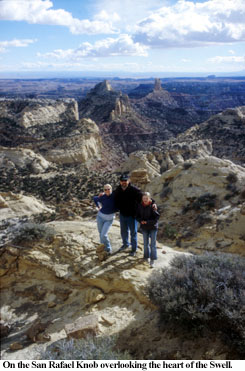 By Golden Webb
By Golden Webb
In Utah's red rock country, desert doubletrack comes in three varieties: bad, abominable, and bug spit. The road I'm driving south on is merely bad, forging a sandy, dusty, rutty route into the great oval-shaped anticline of the San Rafael Swell. From my vantage here in the Upper Muddy River badlands I can see the Swell's western flank as it rises to the horizon: a general upslinging of the land toward Sinbad and the naked rock of Hondu Country, with nothing whatever to suggest the labyrinthine gulf of Muddy Creek on the other side.
That seems to be the central characteristic of the Swell: nothing as it appears, with a surprise around every bend. Visitors here encounter mile after mile of burnt-out hardpan and rotten talus slope, brooding basalt-capped mountains, serrated fins of volcanic rock that radiate across the land for miles like some Mesozoic Maginot Line (to keep us out? to keep something in?), bottomless slot canyons, disarticulated horse skeletons, hidden valleys and poison gulches, glittering beds of selenite, Grendel, Gollum, Sauron, Satan, various and sundry Fremont Indian devils, and the occasional moon-faced cow.
The first Mormon settler to encounter this rawboned wasteland probably took off his hat, sighed, and spat in the dirt. Early ranchers said of the area, "One must not touch it." Today it's a world-class destination for hiking, off-roading, canyoneering, and mountain biking, attracting crowds that rival those of nearby Arches and Canyonlands national parks. Case in point: On this Monday evening in early February, on a forsaken dirt road in the middle of the middle of nowhere, I pass the following: a Nissan SUV full of smiling mountain bikers; an old Indian woman with a canvas bag swatting at ricegrass with a switch (collecting seeds?); and a couple in a red Ford truck with the windows rolled down, towing a horse-trailer. As I pass by I wave at each in turn. Everybody in the Nissan waves back, the Indian woman never looks up, and the guy in the Ford gives me a long look that seems to say, "What are you doing out here, idiot?"
Not much, buddy-just a pilgrim for beauty seeing what lies beyond yonder hills. I climb the pass between Cedar and East Cedar mountains, intersect a faint trackway coming in on the left, and follow it southeast toward the ominous black belly of the Moroni Slopes. I could have gone west on another track, or straight south, or southwest, or looped around north again: different paths following different routes to nowhere. As a wise man once said:
I like a road that leads away to prospects
bright and fair,
A road that is an ordered road, like a nun's
evening prayer;
But best of all I love a road that leads to
God knows where.
I gun across a sandy wash, lurch over a whaleback; rattle to the top of a rise . . . and roll to a stop. The road ends at what looks like the Edge of the World: just another place in the Swell, like a million others, that's so damn beautiful and otherworldly you can't even wrap your mind around it. I step out onto slickrock and walk to the brink, to a spit of sandstone high above Segers Hole, and look out over the superlative chasm of the Lower Muddy Creek Gorge where it cuts through the wall of the San Rafael Reef. The sun is sinking low in the sky, the dying sunlight moving in pulses across the sandstone. Way off in the distance Temple Mountain glows like an ember, like a shining beacon atop its battlement in the heights of the Reef.
"There are two ways to experience the plateau country," writes Gibbs W. Smith. "One is to enter the canyons-to go down, become immersed and swallowed and consumed in a canyon." The other "is to gain a perch on high ground to assimilate the grand view and find perspective, to allow your eye and mind to penetrate and become immersed." There's a third way, I'd submit, and that's to drive its dusty, rutty roads. The San Rafael Swell has all three: deep canyons, grand views-and God-knows-where roads winding mile after mile, with a surprise around every bend.

